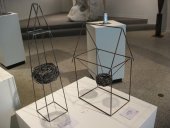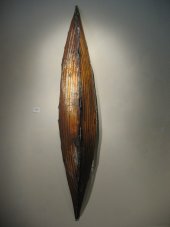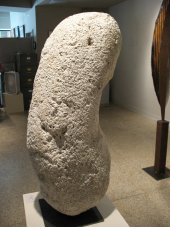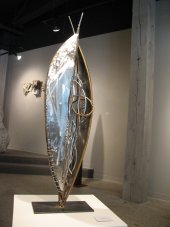 There
is a delicious communication between an artist and an audience
through the created works. The movement of ideas into art gives off
meanings that we, the audience, can then discover from our own
understanding.
There
is a delicious communication between an artist and an audience
through the created works. The movement of ideas into art gives off
meanings that we, the audience, can then discover from our own
understanding.
Adding the energies and sensibilities of two artists to this mix can be like two cooks in the same kitchen, bumping into each other, working separately but inspiring each other, or blending into a new persona.
Skip Willits and Kristin Garnant have been working together for the past six years and are forming a provocative collaborative voice while maintaining their own visions. In each other's company and influence, they have combined their different sensibilities and technical knowledge to give us a new collection of 40 pieces: sculptures, three-dimensional assemblages, and drawings. Their joint show - through June 30 at MidCoast Gallery West in downtown Rock Island - lingers like a story we've read, playing back in our memory.
Willits is well-known in the area for his welded masks and human forms in metal, his original eye, and his casual, quirky intensity. He was taught welding by his father, Vernon, who still inhabits his studio and still offers expert advice on technique and construction. The younger Willits is interested in the creative process, working with many preliminary sketches, and he shows the artist's hand in the work, rather than effacing it. He brings an energetic mood to his combined pieces with Garnant.
She comes from a literary, graphic arts, and printing background. Garnant is more thoughtfully conceptual, has the ability to visualize the final piece in space, and plays with what she sees. She brings a quieter, more elegant tone to the combined work.
Together, their art becomes a play between control and freedom, between thought and the play of making, and between ideas and instincts.
Pods and Houses
Welded metal forms, large and small pieces of foam, graphite on canvas, and wood boxes with artifacts make up the surfaces of their sculptures. All seem quietly intuitive, with a human feeling, and not self-consciously constructed or finished. But beneath the surface, they are full of energy.
My favorite pieces are the six beautiful and excellent three- to four-foot-long welded Corten steel arcs, which the artists call "pods." Like tall, three-sided metal wedges, they stand as long, thin leaves or slim canoes on end, sometimes open on one side. They shape a beautiful and elegant space in the air, like a falling cascade of thin metal water, or the curve of a thought through time. Except for one hanging on a wall, these arcs, or pods, are all attached by their point to long, solid, perfectly proportioned rectangle stands, which are then welded to a thin, flat base of the same colors. Grouped together, they could act as vibrant guardians, defining and protecting a space.
One called Chrysalis seems like an opening milkweed pod uncurling shiny silver tendrils, or like an insect transforming, only very large for an insect, and entirely nonthreatening. Another, called The Suchness of Reality, flies up and outward in an elongated, rusted-metal energy, barely able to hold still on its base.
 The
large wall piece, Beating Heart
of a Barge, really looks
like a canoe, only out of rough metal, with a center seam that
appears to be incompletely "sewn" with metal strands showing
between the sides. It looks like an old, faithful boat being
repaired, or a new one being slowly made out of bark or leather, like
a relationship being pieced together. Even inside them, behind,
facing the wall, the connecting rods seem like seats to be used for
Skip's and Kristin's thin metal people sculptures. This is a good
example of the two artists coming together to form one entity.
The
large wall piece, Beating Heart
of a Barge, really looks
like a canoe, only out of rough metal, with a center seam that
appears to be incompletely "sewn" with metal strands showing
between the sides. It looks like an old, faithful boat being
repaired, or a new one being slowly made out of bark or leather, like
a relationship being pieced together. Even inside them, behind,
facing the wall, the connecting rods seem like seats to be used for
Skip's and Kristin's thin metal people sculptures. This is a good
example of the two artists coming together to form one entity.
There are also several delicate see-through "houses" that the two have been making, in multiples. They are like air drawings of the outer lines of a house, except formed of wire - a pencil line in space - with steep roofs and open-spaced, with no door. But inside each structure they have now placed a coiled nest, hanging or suspended by subtle wire lines. One house has become a tall tower with a nest. The effect is charming, lovely, and graceful. Not surprisingly, the swirling energetic nest is Skip's idea.
Near the middle of the gallery stand three slowly curling ladders on a round curving base, shiny in aluminum, with rungs of syncopated distances, some close, some not, in no continuous rhythm. Like an eccentric DNA spiral of triplets, they soar into the air, curving up and away, harmonizing the spaces between them, elegantly, almost musically, like three voices rising. Perhaps the third voice belongs to Willits' father.
Writing
On the far back wall to the right, up the platform steps of the gallery, are four canvases by Willits - two with white backgrounds and two with yellow - that were inspired by Garnant. On them Willits has penciled lines and lines of words, which streamed freely through his hand at the moment of writing. And then over them again in another direction are more words, creating layers of script, building up into triptychs of graphite linear shapes. In Forest Dirge, this vertical and horizontal overlapping creates forms reminiscent of the artists' Kimono series.
One piece looks like an undulating flag. In another, Willits has left the smudges from his left hand as he wrote, forming beautiful, accidental gray tones, giving us feelings of passing time or memory, as if these words came from another era. Because the words overlap, most are unreadable, although some small passages can be made out.
They remind me of the delicate and energetic "white writing" of layered calligraphy by the West Coast artist Mark Tobey, and the letters that soldiers wrote during World War I, when paper was at a premium, and their letters home were written both horizontally and vertically, saving space.
This writing as form has already appeared in these artists' work, decorating Garnant's long sheets of bronze sculpture, on his banners, and most recently on these canvases. This is a new, but consistent, direction for Willits - gestural, energetic, linear, personal, and also, by their overlapping, suggesting his forms in space.
Foam
 Four
sets of foam sculpture are included in their show, three
floor-standing and one set on the wall. These are Noguchi-like
sculptures, looking purposeful and accidental at the same time, with
open Henry Moore-like holes, hollow spaces, and crevices suggesting
human forms, like sandstone shapes in the desert created by water and
wind.
Four
sets of foam sculpture are included in their show, three
floor-standing and one set on the wall. These are Noguchi-like
sculptures, looking purposeful and accidental at the same time, with
open Henry Moore-like holes, hollow spaces, and crevices suggesting
human forms, like sandstone shapes in the desert created by water and
wind.
One looks like the carved edge of a mountain suggesting a face in relief. Another, a beautiful curving white shape called Swan on the Marsh, looks like an antique Roman torso fragment long-buried in the sea. One more appears to be from a ruined pillar from ancient Persia. But in reality these are all found objects washed up and pulled from the shore of the river by the artists. All are complete and ready to be cast.
Are they art or only natural accidents that are recognized as beautiful and moving by the eye of the artists who would put them into a gallery? Both ideas are possible, but their best art is handmade by the artists.
Boxes
On the back left wall of the gallery are nine small, old wooden pull drawers, hung in a row - Garnant's work - filled with collected images and objects, inspired by Joseph Cornell assemblages.
Inside are quiet arrangements formed by countless shells, antique photo tintypes of anonymous people, small pinned cutout butterflies, little feathers, a single robin's egg, clean little white animal skulls, the base of a turtle, old circular metal tin-can tops, and a cut-off book. They speak to me of the memory of the common man, of the little experiences of everyday life that can be translated into visible art, and the freedom in making free associations and playing.
 In
the lovely box assembly I Dreamed
a Journey, the color white
permeates in multiples. A row of little white seashells frames an old
portrait tintype, crossed behind by thin white strings of attachment.
Above this, three white feathers poke out of a small origami envelope
made of faded and folded newspaper. Behind this, brushed white has
been hastily painted as a backdrop against the faded wood grain.
Images melt into a feeling of wanting to fly away in imagination, in
time, perhaps to the past.
In
the lovely box assembly I Dreamed
a Journey, the color white
permeates in multiples. A row of little white seashells frames an old
portrait tintype, crossed behind by thin white strings of attachment.
Above this, three white feathers poke out of a small origami envelope
made of faded and folded newspaper. Behind this, brushed white has
been hastily painted as a backdrop against the faded wood grain.
Images melt into a feeling of wanting to fly away in imagination, in
time, perhaps to the past.
I passed over the work made with long sticks, skinned by the river beavers, which the artists had collected and tied together and assembled into a kind of funeral pyre. Also, there were these same skinless sticks placed through old black typewriter cases with simple white drawings on the case. The drawings seemed an afterthought; their meaning seemed fragile. Traveling sticks? The combination of nature and human order? For me this direction is a cul-de-sac for the artists, relying on the easy combination of found natural objects, with little opportunity for serious play.
It's always interesting to look back on the progression of artists and the work we have known, and then to look forward to their journey through time. We have seen Willits' metal work for many years. Now, with his able collaborator Garnant, a new level of subtly quiet energy, and mystery has emerged between them to form new and possible directions while still maintaining the strength and energy of their past work.










